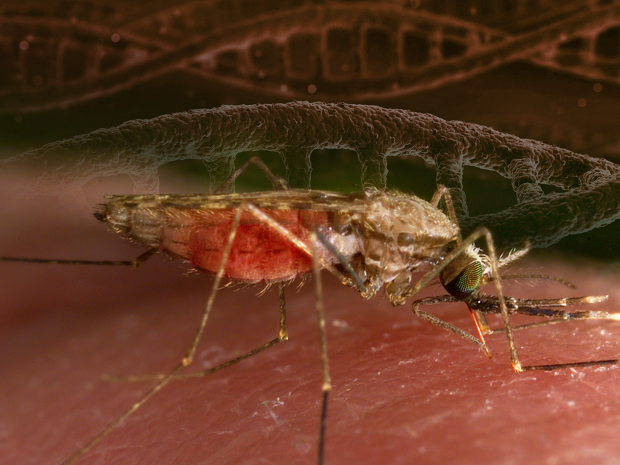
Read the latest Issue
The genomes of 16 Anopheles mosquito species have been sequenced and compared, providing new insights into the dynamic evolution of Anopheles and adding substantially to the research arsenal against malaria and other vector-borne diseases.

An international team of scientists has sequenced the genomes of 16 Anopheles mosquito species from around the world, some of which are notorious for transmitting malaria. Published in Science, the results provide important insights into the dynamic evolution of these vectors. The annotated datasets are freely available in VectorBase, a consortium involving the University of Notre Dame, Imperial College London and the European Bioinformatics Institute (EMBL-EBI).
Some species of Anopheles mosquito transmit parasites that cause malaria in approximately 200 million people every year. However, the vast majority of Anopheles species are merely annoying. The researchers mapped genetic differences between deadly vector species such as Anopheles gambiae and their harmless cousins. The results provide a genetic basis for understanding how these mosquitos adapt so quickly to new environments.
The capacity of a vector to transmit malaria is determined by many factors, including feeding practice, breeding preferences and immune response. In 2002 the Anopheles gambiae genome sequence provided the basis for many large-scale studies that have since shown how this species adapted to live amongst and feed upon humans. But the sequencing data published today will allow scientists to compare many species and identify crucial genetic differences.
“We selected species from Africa, Asia, Europe, and Latin America that represent a range of evolutionary distances from Anopheles gambiae, a variety of ecological conditions, and varying degrees of vectorial capacity,” said lead investigator Nora Besansky, Professor of Biological Sciences at the University of Notre Dame.
The samples were obtained from mosquito colonies maintained at the United States Centres for Disease Control and Prevention, and wild-caught or laboratory-reared mosquitoes from scientists in Africa, India, Iran, Melanesia and Southeast Asia.
“Getting enough high-quality DNA samples for all species was a challenging process, and we had to design and apply novel strategies to overcome the difficulties associated with high levels of DNA sequence variations – especially from the wild-caught sample,” said Daniel Neafsey of the Broad Institute, who oversaw the sequencing efforts.
“We used similarities to genes from Anopheles gambiae and other well-studied organisms such as the fruit fly to learn about the possible functions of the thousands of new genes found in each of the Anopheles genomes,” said Robert Waterhouse of the University of Geneva Medical School and SIB-Swiss Institute of Bioinformatics.
This will be of great use to data-hungry malaria biologists.
Scientists from the VectorBase group at EMBL-EBI performed genome annotation to identify both protein-coding and non-coding RNA genes.
“We need to assign functions to the genes we’ve identified,” explains Dan Lawson, VectorBase project leader at EMBL-EBI. “To start that process, we combined our new knowledge of genetic similarities between Anopheles species with our knowledge of the functions of similar genes in well-studied organisms such as the fruit fly.”
Examining gene evolution across the Anopheles revealed high rates of gene gain and loss, about five times higher than in fruit flies. Some genes, such as those that encode proteins secreted into the mosquito saliva, are only found in subsets of the most closely related species. These dynamic changes may offer clues to understanding why some Anopheles can only survive in brackish water while others require fresh water, or why one species is attracted to livestock while another will only feed on humans.
“These data provide an incredible platform for building a rich knowledge base,” says Paul Kersey, head of Non-vertebrate Genomics resources at EMBL-EBI. “This will be of great use to data-hungry malaria biologists. Anyone can use the data, which are freely available in VectorBase, and contribute their expertise and knowledge to a resource of great utility to public health.”
This post was originally published on EMBL-EBI News.
Looking for past print editions of EMBLetc.? Browse our archive, going back 20 years.
EMBLetc. archive